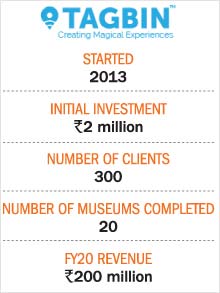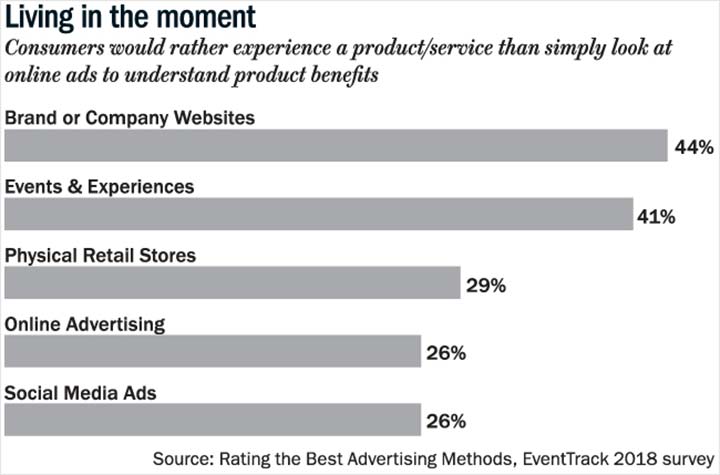
Usually, museums gather dust. History snoozes inside their confines, instead of coming vibrantly alive. A Gurugram-based start-up is working on changing that. It is using experiential technology to upgrade museums — with ‘talking’ walls and pillars, ‘time-travelling’ freedom fighters and installations that yank you into battlefields, to face firing cannons and armed cavalry.
Tagbin has redone 20 museums and monuments across the country, so far. It is now working on the most ambitious museum project of this government, the Prime Ministers’ Museum in Delhi. With a budget of a whopping Rs.3 billion, it will shed light on lives of different heads of the nation. To win this contract, the tiny start-up had to compete against some of the biggest architectural and design firms such as Abha Narain Lambah Associates, Archohm Consults and London-based Muse.
The young company has grown fast. Started with an initial investment of Rs.2 million in 2013, it posted revenue of Rs.200 million in FY20. Not bad, but Tagbin relies a great deal on government projects. It gets 90% of its revenue from them, and the remaining 10% from experiential marketing projects done for corporates. Bigger museum projects are usually allocated Rs.5 billion-Rs.6 billion in total, and Tagbin gets 30-40% of that. Corporate projects are usually allocated Rs.6 million or more, and Tagbin gets 40-50% of the total project cost. Besides that, for operations and maintenance of various project sites, the start-up makes Rs.300,000-500,000/month.

Beyond the books
When founder Saurav Bhaik was studying at IIT Roorkee eight years ago, experiential marketing (which prompts a person to interact with the brand) was a new concept, unlike today when it is widely adopted (See: Living in the moment). According to a 2018 report by The Event Marketing Institute and the US-based experiential marketing agency Mosaic, around 84% brands feel experiential marketing cannot be done without. The report also found that nearly 85% consumers are likely to buy after participating in an event or the experience of the brand.
Also, marketing agencies (which execute campaigns, like Tagbin does for its corporate clients) have a larger say. Brian Tellis, co-founder & group CEO of Fountainhead MKTG, says that earlier a campaign was conceived by the marketing department of a brand and the agency merely executed it. “Now, many agencies are going deeper into consumer behaviour, and are actually strategising with the marketer on what would work well,” he says. But that is today.
Back in 2012, when Bhaik was at IIT Roorkee, marketing was still done in a conventional manner. He recalls trying to raise sponsorship for his college fest ‘Thomso’, and wanted to offer something different to the sponsors from the usual carrying of the logo on badges or T-shirts. He convinced Docomo with his experiential marketing package, by making RFID bands for each visitor at the fest. Each time a user tagged the fest on his or her social media handle, Docomo would automatically get tagged as a sponsor. There were other engagement hooks at the fest, such as selfie booths. The campaign was successful, Docomo trended on Facebook for a couple of days with 40,000 visitors posting and hashtagging the brand. Six months later, Bhaik was called to IIT Bombay for its Mood Indigo fest to repeat the same campaign for Cadbury Oreo.
After graduating in 2013, the brand manager of Docomo got in touch with him again to do similar branding projects for the company. That’s when Bhaik formally started Tagbin and acquired a few more corporate clients. Within three months, he also got his co-founder and CTO, Ankit Sinha on board. For the next two years, they worked with many companies before chasing museums. Their client list included GAIL, Coca Cola, Audi, Dell, HCL, Colorbar, Bharat Petroleum, Lenovo, Levi’s, Livon and Microsoft.
There were other interesting campaigns too. One was for a liquor company, which wanted to promote responsible drinking. Tagbin created a car racing video game and placed them in high-end restaurants and pubs. Customers were invited to play, and most crashed their car when another vehicle came rushing onto their view. This made drinkers experience their slower reaction time to any surprise and appreciate the danger they were putting themselves in. “We managed to persuade 5,000 drunk customers to take a cab,” says Bhaik. The campaign, which ran for three months across 20-30 cities, cost the company Rs.6 million. Another was for LetsTrack, a vehicle security company. Tagbin designed a holographic salesman for them explaining features of the security product (app and tracker) at dealerships. “The impact of Tagbin’s campaign exceeded our expectation by helping us capture customer attention,” says Rachitta Juneja, CMO, LetsTrack.
Dipping into history
In 2015, the start-up began working with museums. That was the year the Centre launched the Swadesh Darshan Scheme. As part of it, the government floated Rs.380 million tender for upgrading Red Fort with an additional maintenance contract worth Rs.50 million. “It’s not easy to crack a government project,” says Bhaik, adding, “There are too many rules, and you need prior experience.” Tagbin was a newbie. Thankfully, there was no company specialising in creating digitised museums. The start-up, on the other hand, had technologists, space designers and architects on its rolls. But as they were in unknown territory, they needed someone who had experience in working with the government. So, Tagbin tied up with Expression 360, a media and marketing company that had earlier worked on Champaran Satyagraha Museum for National Archives of India.
The company created five museums inside Red Fort, including the popular ones Yaad-e-Jallian and Azaadi-Ke-Deewane. First is on the Jallianwala Bagh incident, where over a thousand were injured and hundreds massacred by the British Indian Army, and the second on lesser-known freedom fighters. According to Archeological Survey of India, post the revamp, the number of daily visitors to the monument went up from 5,000 to 7,500, and they were spending a longer time there. Tagbin had got a foot in the door.
They slowly built their credentials, started networking with various government departments and eventually decided to go it alone without the JV partner. According to Harminder Sahni, founder of Wazir Advisors, which advises companies on consumer and retail strategies, companies (that work with government agencies) usually build on a reputation that they have gained from completing one project. “When you complete one, you will be considered for the next bidding. Secondly, you get the bragging rights of having worked with that institution,” he says. Tagbin slowly won other projects, too, including Ami Kolkata (on the city’s history), Textile Museum in Delhi, National Library in New Alipore (Kolkata) and Satya Sai Museum in Bengaluru.
The future
These are orders with an impressive profit margin, so who is to say that a bigger player won’t muddy the waters for Tagbin. Sahni says that it is a myth that large and small companies can’t co-exist in a space. According to him, clients may actually prefer to work with smaller start-ups because senior level management or the founders would be involved in the process, unlike with the bigger experiential marketing agencies. That said, too niche an offering can have its own downside. “Your ways can become too monotonous,” Sahni cautions, adding, “ultimately, these start-ups are into designing and not into developing a new technology or innovation.”
Fountainhead MKTG’s Tellis though thinks it can be Tagbin’s strength — that it is not in the technology business but in the museum business. “It is about how you apply technology in certain businesses and industries, and make a difference,” he says. Museums might be a niche market and to grow the start-up’s founders will need to get back to mainstream experiential marketing for greater glory. They already have project execution and technological wonderment, as their edge.











